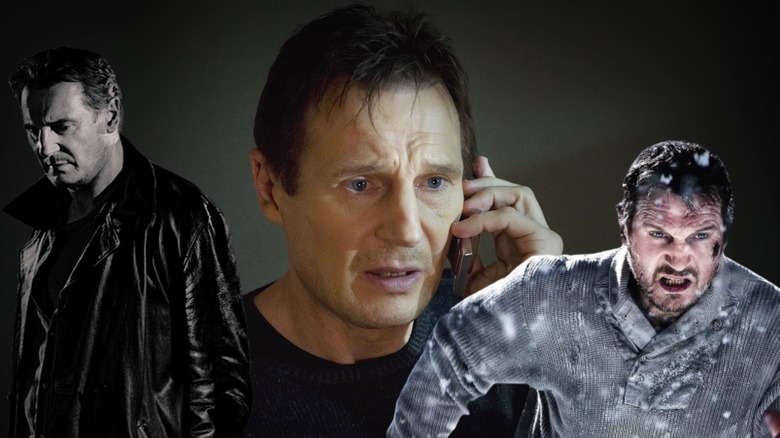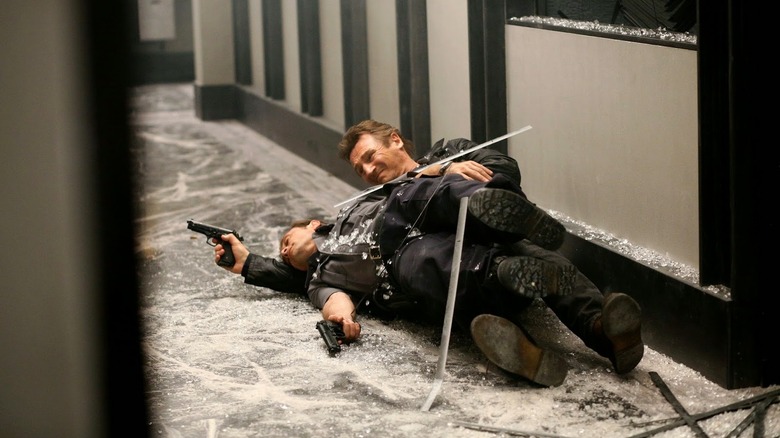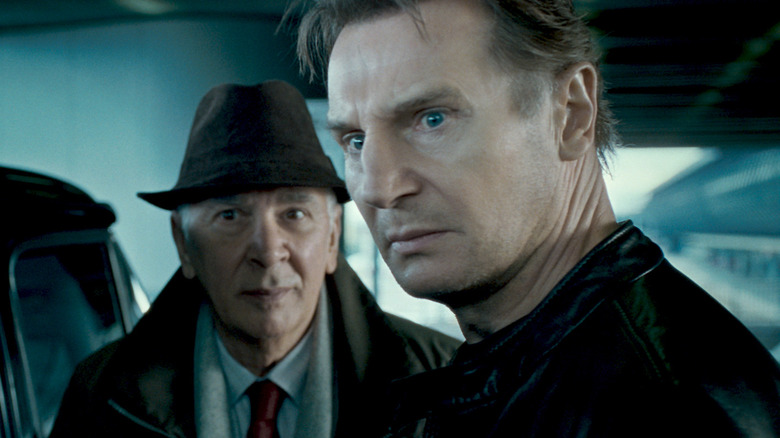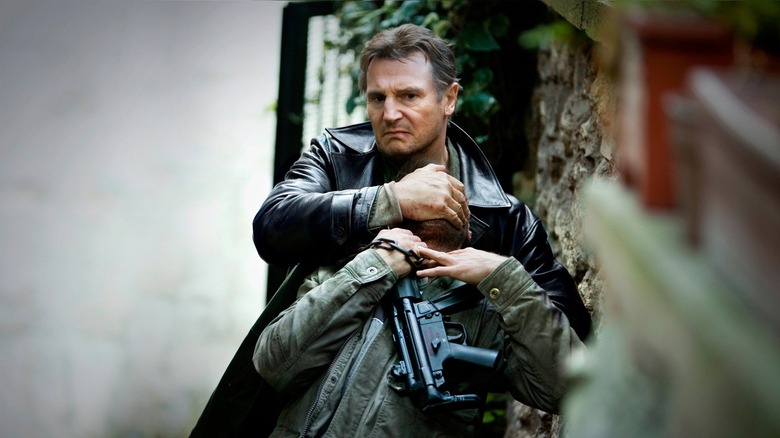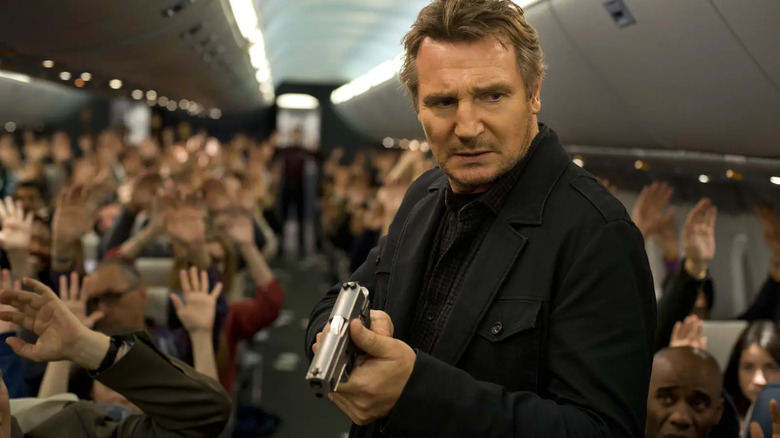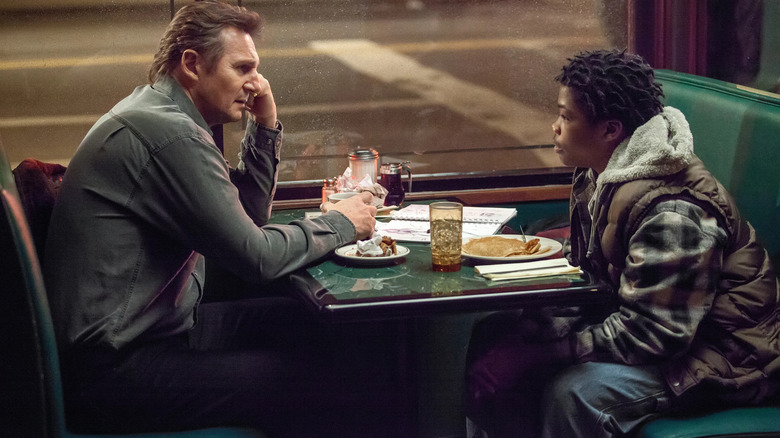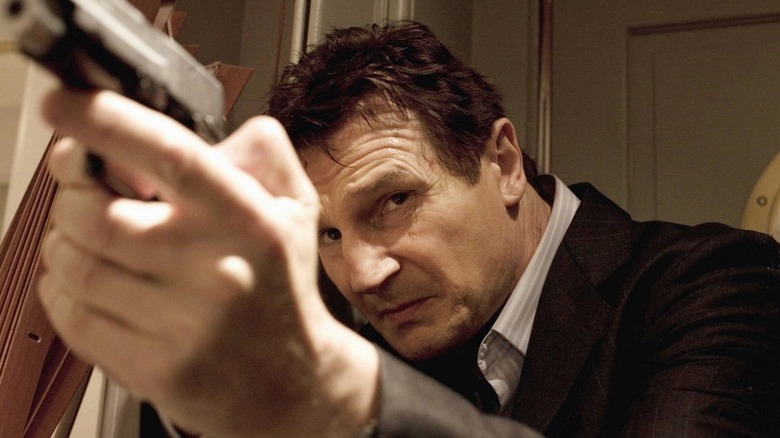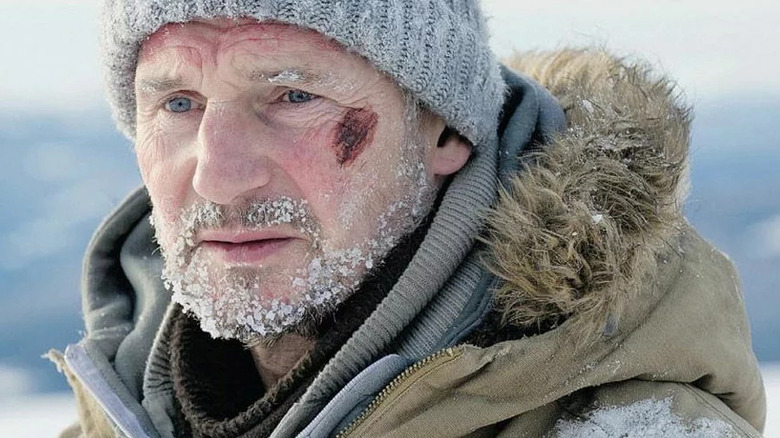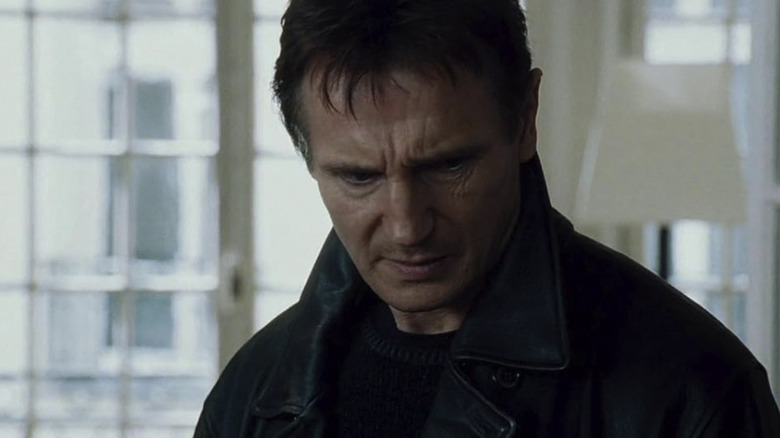The Taken Movies Ranked From Worst To Best
Pierre Morrel's 2008 film "Taken" is brazenly morally irresponsible.
"Taken" was not so much a thriller as an indulgent "dad fantasy," rooted in xenophobia and male sexual hysterics. The lead character, Bryan Mills, played by a wholly devoted and utterly capable Liam Neeson, was a divorced dad of a teenage girl named Kim (Maggie Grace) who saw his clout as a parent disappearing into the wealthy black hole of a cold-shouldered ex-wife (Famke Janssen) and her attentive new husband (Xander Berkeley). Bryan is a former CIA agent, and his job kept him away from home enough to damage his marriage. When Kim announces that she and a friend are going on an international holiday together, Bryan warns her that such an excursion is dangerous; kidnappers, he knows, often target traveling American teenage girls and sell them into sexual slavery. It sounds paranoid and everyone dismisses him.
Perhaps predictably, Kim is almost immediately kidnapped and sold into sexual slavery. It will be up to Bryan — middle-aged divorced dad extraordinaire — to use his murder skills to rescue her. Bryan's morals are simple: it's okay to murder a thousand Albanian gangsters if they threaten to harm white American teenagers. It's a power fantasy for violence-minded middle-aged divorced dads everywhere.
"Taken" was so successful that it spawned sequels ... in the form of an entire subgenre: the Post-Taken Liam Neeson-is-a-Violent-Dude subgenre. "Taken" is the first film in this series, but other films unrelated to "Taken" still count in my mind as sequels. "Taken" was "Taken 1," "Unknown" was "Taken 2," "The Grey" was "Taken 3," "Taken 2" was "Taken 4," "Non-Stop" was "Taken 5," and "A Walk Among the Tombstones" was "Taken 6," and "Taken 3" was "Taken 7."
That said, let's rank the seven "Taken" movies from worst to best.
7. Taken 3 (a.k.a. Taken 7)
The coolest thing about 2014's "Taken 3" is the name of its director, Olivier Megaton. Apart from that, "Taken 3" feels less like a straight-up sequel to "Taken" than one of its many lackluster straight-to-video knockoffs (which Neeson, incidentally, also starred in from time to time). The plot involves the murder of his ex-wife Lenore (Janssen), and his vengeful tracking down of her killers. The action is generic and terrible and makes no sense. "Taken 3" was the object of widespread derision when a seven-second clip was posted online of Bryan Mills jumping over a fence. The seven-second clip featured 14 edits. It was everything wrong with action filmmaking in a nutshell. Neeson was in his early 60s at the time, so some editing may have been required to depict him moving far more quickly than a 60-year-old ordinarily might, but, golly, was this film chopped to pieces.
6. Unknown (a.k.a. Taken 2)
Jaume Collet-Serra's 2011 thriller "Unknown" begins with an intriguing premise, worthy of the notable 1995 UPN series "Nowhere Man." Liam Neeson awakens from a four-day coma only to find that no one recognizes him, including his wife and close friends. He can't seem to find any evidence of his existence. The film, sadly, is not savvy enough to imply that Neeson's character may be going mad, and merely delves through a nondescript detective plot to find a foregone conclusion. Like "Taken," there are a lot of panicked races through an exotic European city, in this case, Berlin. "Unknown" is as forgettable as its title might have you believe, and possesses none of the slickness that Collet-Serra brought to his generic Disney adventure "Jungle Cruise," nor any of the fun wicked energy of his "Oprhan." The best thing about "Unknown" is the presence of Diane Kruger, who dazzles the universe without even trying.
5. Taken 2 (a.k.a. Taken 4)
The gimmick of "Taken 2" is that Bryan and Lenore are the ones who are taken, and a large portion of the movie is devoted to their daughter Kim tracking them down. It seems that one of the victims from the first "Taken" had a powerful father, and he vows revenge against Bryan Mills, very much in the same way Bryan vengeance'd all those Albianians. Maggie Grace proves to be a capable action heroine in her few running-across-the-rooftops scenes, although it will be Bryan who ultimately commits the most violence, natch. The exotic setting this time around is Istanbul, and director Olivier Megaton makes great use of the city's famed Hagia Sofia as a landmark. It's a watchable film, but little more. I have seen the film twice, and it still didn't leave much of an impression.
4. Non-Stop (a.k.a. Taken 5)
Collet-Sera's "Non-Stop" is just as dumb as the previous films on this list, but it emerges as one of the better films in the unofficial "Taken" series by mere dint of its insane Liam Neeson performance. In "Non-Stop," Neeson plays a gruff ex-cop (of course) who gets a text message on an airplane informing him that a random passenger is going to die every 20 minutes unless he transfers $150 million into an untraceable bank account. Neeson storms about the plan like a crazy man, wrenching phones out of people's hands and waving a gun around, looking for the culprit. Could it be notable lead actress Julianne Moore? "Non-Stop" may have been a post-9/11 coping mechanism, but it serves instead as a kooky distraction that would play perfectly well when watched on an airplane.
3. A Walk Among the Tombstones (a.k.a. Taken 6)
Scott Frank's "A Walk Among the Tombstones" is also somewhat forgettable ... wait. What was this film about? Heck, have I even seen it? I remember seeing a film with Liam Neeson and Dan Stevens, I think, so I'm pretty sure I saw "A Walk Among the Tombstones." What might be recalled accurately is that Scott Frank actually constructed a downbeat noir film, moodier and less action-heavy than the other "Taken" films on this list. I definitely recall the diner scene pictures above, and I recall Dan Stevens, handsome devil that he is, giving a good performance as a drug kingpin. I remember a brutal close-quarters fight involving a garrotte wire and a cleaver. However well it might be remembered, its moodiness stands out, as does Neeson's trademark hollowed-out ex-cop character. It's certainly better than "Taken 3."
2. Taken (a.k.a. Taken 1)
The original "Taken," described above, may be morally irresponsible, but that's probably part of the film's twisted appeal. It's clearly and pathetically a power fantasy for grumpy dads, and it does everything it can to justify murder as a reasonable course of action, but those things add to the film's outrageous charm. It has the nuance and moral subtlety of any number of B-action movies from the 1980s but possesses a unique Eurosleaze charm that only screenwriter Luc Besson could provide. This is a film for the lizard brain, an unabashed display of id. It is so hateful and blunt one can't help but admire its bleak purity. I love "Taken," even though I 100% disagree with its politics. It's no wonder that it inspired an entire subgenre of films and has buoyed much of Liam Neeson's career for the last 15 years.
1. The Grey (a.k.a. Taken 3)
Joe Carnahan's 2011 film "The Grey" promised to be a salacious thriller. Liam Neeson plays a man, standing on the brink of self-slaughter, whose plan crashes in a snowy wilderness among a pack of vicious wolves. Prior to its release, "Taken" fans hoped that "The Grey" would feature a lot of awesome action scenes of Neeson fistfighting wolves. After its release, audiences found a calm and harrowing tale of nihilism and atheism. As Neeson and his fellow survivors track their way through the woods to an unknown rescue, they begin to die off one by one, untrusting and unskilled in wilderness survival. Eventually, Neeson will be the only one left standing. Hopeless and pondering the losses in his life, he wails at the heavens, imploring God to interfere, to help, to do something.
When the sky remains quiet, Neeson mutters "F*** it, I'll do it myself." "The Grey" is assertively about loss, despair, and the persistence of pained life in a godless world. It's handily better than an entertaining puffball like "Taken."
How this list was made
This ranking was created through a combination of independent research and expert opinion. We compiled all relevant data, studied/watched all relevant material, and used our best professional judgment to determine the order of the list. The final order was determined by examining the larger cultural ramifications of each entry, as well as our take on the material, as determined by the past year of our work and analysis at /Film.
